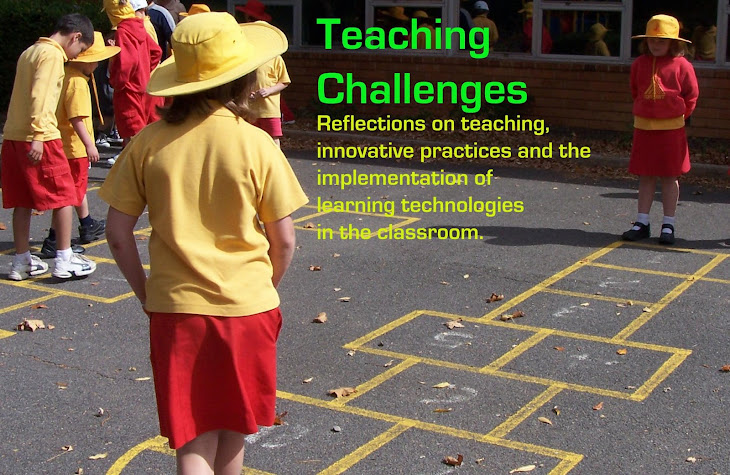Last Thursday and Friday I attended a Professional Development course on "Circle Time". My previous knowledge going into this course was that circle time is a touchy-feely way of dealing with the social-emotional aspects of classroom learning. This course, however, took it beyond the emotional literacy aspect, to explore it as a strategy for teaching all areas of the curriculum. This idea really got me going.
Circle Time is generally run with the whole class (including the teacher) sitting in a circle in chairs. For me, this means rearranging the room each time - moving the desks to the edges so there is space for the circle. My class is getting much better at this.
There are 6 key parts to Circle Time:
Check In - This is where each student says their name, and completes a sentence as pre-determined by the teacher. eg. "Hello, my name is Sarah, and I can spell the word frog." An object is usually passed around the circle to indicate whose turn it is to speak.
Mixer - This is essentially a game of some sort that gets everyone to move about and end up at a different seat to where they started, and preferably with people they don't usually work with (hence the name - Mixer).
Central Activity - This is where you teach the content, and have students work on a task related to the content.
Debrief - Students report back/share the work they completed.
Energiser - This gives everyone a chance to move around and shake off all the concentration they've just had to apply. Any game or activity that achieves this can be used. I try to find a way to link it to the theme, if possible.
Check Out - This is much like the Check In, except that children share something they learnt from the session, or suggest an application of the new knowledge.
So far this week, I have run a circle time each day.
On Monday, we had a Spelling Circle Time. The Check In, Energiser and Check Out were all spelling focused. For the Central Activity, students were given their new spelling words and worked with a partner to discover strategies to help them remember how to spell their words. For example, one girl pointed out that for 'cart', you just spell car, and then add a t. Another said that 'down', is own with a 'd' at the start. As it was my first circle time, I was pleasantly surprised to hear back what students had gained from the session, despite how wriggly they were.
On Tuesday, we had an Integrated Inquiry Circle Time. The Check In, Mixer, Energiser and Check Out were all related to The Legend of Nian (a Chinese dragon), which the students read last week. For the Central Activity students worked in pairs to colour a dragon head and design the body using scraps of coloured paper. We looked at some pictures of dragons on http://www.flickr.com/ to get some inspiration. Again the students were engaged and enthusiastic about their new learning. (By the way - this ties into our Olympics unit of work as we are exploring the culture of China.)
Today I ran a Maths Circle Time. The main concept was Position and 'the garden' was its vehicle. For Check In, students described their own gardens at home. The Mixer was some flash card practice of adding 9. During the Central Activity, students did an interactive activity I'd made on the Smart Board where they followed instructions to add clipart pictures to photos of gardens. Then, in groups of 4, students made plasticine gardens, within the constraints of a list of instructions that I gave them. For example: Put some fish in a pond. Put some rocks around the pond. The Energiser was a ball passing activity where students passed the ball using the positional terms - over, under, through, around etc. Finally, during the Check Out, students said what they learnt from the experience, and there were a lot of great comments about the value of cooperation.
So far, I feel that this is a successful strategy because ALL my students have been engaged and excited about the central activity. They have been working cooperatively with people they don't usually choose to play with. Secondly, every child is getting a chance to voice their thoughts and ideas. Usually I have about 4 students who insist on being heard, and I miss out on hearing what other students are thinking. Thirdly, I get excited by the whole thing. It's a much more interesting way of structuring lessons, and I finally feel like I'm remembering to conclude my lessons properly!
On the down-side, I'm not sure that it is time effective yet. As it is early days, and we are still getting used to the process, I expect that we will get quicker with time. But at the moment, I find it hard to get through the whole circle time within an hour.
Please contact me if you want any more information about 'Circle Time'.
Wednesday, August 6, 2008
Subscribe to:
Post Comments (Atom)








No comments:
Post a Comment
I'd love to hear your thoughts and questions. Please don't be shy...
:)